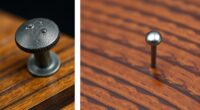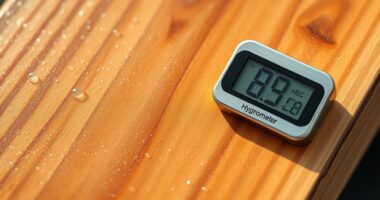Use a marking knife when you need precise, clean lines for joinery or scoring tough surfaces, ensuring accuracy and minimal smudging. Switch to a pencil for rough sketches, layout marks, or softer materials, as it’s quick and easy to adjust or erase. Knowing when to choose each tool helps improve your work’s precision. Keep exploring how combining both tools can elevate your craftsmanship to the next level.
Key Takeaways
- Use a marking knife for precise, clean lines on hard surfaces and metals where pencil marks may smudge or fade.
- Choose a pencil for initial sketches, rough outlines, and softer materials requiring quick, broad markings.
- Opt for a marking knife when high accuracy and fine detail are essential, especially for joinery and scoring.
- Use a pencil during early planning stages to allow easy adjustments and corrections before final marking.
- Combine both tools: sketch with a pencil and then refine with a marking knife for optimal precision.

Have you ever wondered which tool is better for marking your materials— a marking knife or a pencil? When it comes to achieving precise results, choosing the right tool depends heavily on your marking techniques and the type of project you’re working on. Both tools are essential precision tools in woodworking, metalworking, and other crafts, but they serve different purposes based on the level of accuracy you need and the material you’re working with.
Choosing between a marking knife and a pencil depends on your project’s precision needs and materials.
A marking knife is a sharp, narrow blade designed to scribe fine lines directly onto your material’s surface. Its primary advantage lies in its ability to produce very accurate, clean lines that won’t smudge or fade easily. Because of its precision, a marking knife is ideal when you need to make exact measurements or layout lines that will serve as guides for cuts or joins. When you use a marking knife, you follow specific marking techniques—such as scoring along edges or marking the exact location for joinery—that ensure your lines are precise and improve the overall accuracy of your work. This tool is especially useful on hardwoods or metals where pencil marks might not be visible enough or could be wiped away easily.
In contrast, a pencil offers versatility and speed, making it suitable for initial sketches or rough outlines. Its softer, broader mark is easier to see and erase, which is helpful during the early stages of planning or when adjustments are needed. Pencils are also more forgiving when working on softer materials like softwood or cardboard, where a marking knife might be too aggressive or difficult to manipulate. However, pencil marks can smudge, fade, or be accidentally erased, so they’re less reliable for final measurements or critical joints where precision is paramount.
When deciding between the two, consider your marking techniques and the level of accuracy required. If your project demands meticulous detail and crisp lines, a marking knife should be your go-to precision tool. It allows for controlled, fine lines that translate into perfect cuts and fits. On the other hand, if you’re drafting, sketching out ideas, or working on softer materials, a pencil provides speed and flexibility. You might even start with a pencil to map out your layout and then switch to a marking knife for final, exact lines.
Ultimately, understanding when to use each tool enhances your craftsmanship. Recognizing their strengths and applying proper marking techniques ensures your measurements are accurate, your cuts are precise, and your finished work meets your standards. Both tools are valuable, but knowing which to reach for at each stage makes all the difference in producing professional, high-quality results.
Frequently Asked Questions
Can a Marking Knife Be Used on All Wood Types?
A marking knife isn’t suitable for all wood types because of its limitations. It works best on softer woods, where it can easily score the surface without tearing or chipping. For hard or dense woods, the marking knife might struggle, making it less effective. You should consider wood type compatibility and recognize marking knife limitations to guarantee accurate markings. When in doubt, use a pencil on tougher woods for clearer, more precise lines.
How Do I Sharpen a Marking Knife Effectively?
To sharpen your marking knife effectively, start with a fine grit sharpening stone to maintain a sharp edge. Use proper sharpening techniques, like holding the blade at a consistent angle and honing both sides evenly. Regular blade maintenance keeps it precise and prevents dullness. Think of sharpening as fine-tuning a musical instrument—your attention to detail guarantees accurate markings, making your work smoother and more precise every time.
Is a Pencil Suitable for Detailed or Fine Markings?
A pencil is suitable for detailed or fine markings, especially when you need precision shading or soft markings. You can easily create subtle lines or delicate details, making it ideal for project planning or intricate work. Its versatility allows you to erase or adjust as needed, giving you control over your markings. For highly precise or soft markings, a pencil provides the flexibility and finesse that a marking knife can’t offer.
When Is It Better to Use a Pencil Over a Marking Knife?
Imagine your workpiece as a delicate canvas where precision marking guides your hand. You should use a pencil when accuracy matters but your material demands gentle contact, like softwood or delicate surfaces. Pencils excel for detailed lines and temporary marks, offering versatility without damaging your material. When precision marking needs to be easily erased or adjusted, a pencil becomes your trusted tool, ensuring accuracy while maintaining material compatibility.
Are There Safety Concerns With Using a Marking Knife?
Yes, there are safety concerns when using a marking knife. You should wear safety gear like gloves and eye protection to prevent injuries. Handle the knife with care, keeping your fingers clear of the blade’s path, and always cut away from your body. Follow handling precautions, such as keeping the blade sharp to reduce slips, and store it securely when not in use to avoid accidents.
Conclusion
Choosing between a marking knife and a pencil depends on your project’s precision needs. Think of the marking knife as a finely tuned scalpel, offering clean, accurate lines, while the pencil is your trusty guide for quick, rough sketches. When accuracy matters most, go for the knife; for everyday marking, the pencil’s your best bet. Like a skilled artist selecting the right brush, selecting the right tool guarantees your work turns out just right.









